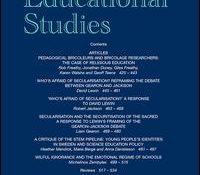eric.ed.gov har udgivet: Children benefit academically when parents and educators work together. For this reason, parents’ involvement in their children’s education is a priority of the “No Child Left Behind Act of 2001.” But a strong connection between parents and educators does not come about automatically. Both parties may need to learn new roles and skills and develop the confidence to use them, especially as parents move beyond traditional activities, like helping children with homework, and toward shared responsibility for school improvement. Intermediary organizations, like federally funded Parental Information and Resource Centers (PIRCs), can help. Drawing on lessons learned from five PIRCs across the country that have been meeting this challenge, this guide shares promising strategies for increasing effective parent involvement. It explains “how to” strategies that the Parent Information… Continue Reading →
Like this:
Like Loading...
eric.ed.gov har udgivet: The objective of preschool teachers should be to determine the mathematical ability of preschool children and improve their skills using meaningful teaching methods through pictorial demonstration and manipulative models. Children who receive number concept instruction through hands-on play models, activities, and discussion show greater understanding in math skills. Teachers should be striving to create a learning environment for their students and help them fulfill their needs through their playful activities. This paper discusses how to integrate math activities into preschool classrooms. (ASK) Link til kilde
Like this:
Like Loading...
eric.ed.gov har udgivet: A mixed-methods research design was employed to investigate the impact of use of learning centers to support language and academic skills of children aged 61-72 months. The sample of quantitative data of the study consisted of 70 children (35 in the experimental group and 35 in the control group). In the quantitative dimension of the study, data were collected using the “Kaufman Survey of Early Academic and Language Skills,” “Progress in Maths 6 Test,” and the “Control List for the Evaluation of the Print Awareness of Pre-School Children” scales. In the qualitative dimension of the study, semi-structured interviews were conducted with the teachers of the experimental group through the “Teacher Interview Form” developed by the researchers. During the implementation period, learning centers were established and organized in… Continue Reading →
Like this:
Like Loading...
tandfonline.com har udgivet en rapport under søgningen “Teacher Education Mathematics”: Link til kilde
Like this:
Like Loading...
tandfonline.com har udgivet en rapport under søgningen “Teacher Education Mathematics”: ABSTRACT ABSTRACT This study examines the emergence and evolution of madrasa as a specific organizational form of higher learning from a comparative-historical perspective. The article begins by discussing how the madrasa emerged and which factors contributed to its rise and spread among the Islamicate political regimes during the Middle Ages and afterwards. Then, it provides a comparison between the medieval European university and the madrasa, with particular attention to the characteristics of the legal systems on which they were founded and the influences of the political environment on the respective institutions. It is argued that the differences in the legal tradition and the political authority structures may help us to grasp why madrasa and university produced different outcomes in terms… Continue Reading →
Like this:
Like Loading...

